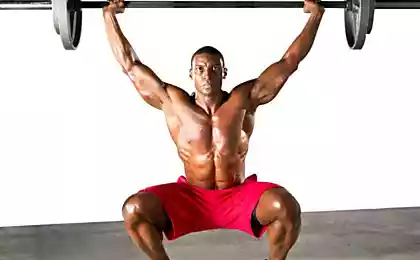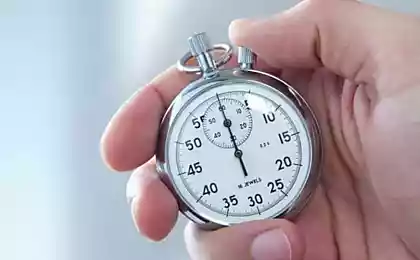520
About exercise, metabolism, heart rate and oxygen debt
In the last few years have seen a surge of interest in so-called "Metabolic training". Ie training, which, in the opinion of the authors and popularizers, provide for a "faster metabolism" for a few hours (maybe even days) after their meeting, effectively thus helping to "burn" fat. I want to note that the name "metabolic training" is not scientific, it is "popular" or advertising, the exact meaning has not. This term describe variety in form and nature of the load of training, nothing to do, often, each other of not having.
Also note that in the quotes I took and the expression "metabolic boost". The expression is popular, but not very correct. In fact us should be interested in not the rate of occurrence of certain chemical reactions, and how much energy the body spends on certain to your needs. Understandably, interest in connection with the issue of reducing extra fat stores.
So, what guided those who call any workout "metabolic"? They focus on the intensity, or rather, any parameters that are, from their point of view, are indicators of the intensity: heart rate (heart rate), subjective feelings of heaviness or complexity of the transfer of a load ("off"), the feeling of shortness of breath, sweating, pain in the muscles. You've probably heard such comments: "Wow, that was a great workout, legs are trembling, nearly dropped dead muscle the next day ached brutally".

Well, how could it be otherwise, because in our subconscious tightly linked causal connections images-pictures: drenched in sweat tank top sportsman champion, an expression of extreme tension on his face, a stern coach with a stopwatch in hand, "faster, faster, be patient, don't give up", swollen to a record snatch muscle up in the ecstasy of his hands, "victory!!!", and now the owner of a beautiful, athletic body on the podium, the champion Cup, champagne ...
In short, you want success – be patient, take it easy, go on record, squeeze out all the juices, as they say "through thorns to the stars"... This "heroic style" carries over into the rest of our practice: the development of a beautiful body, career, earnings...
So, about the intensity. "Intensity", as well as volume — variety characteristics of the training load applied, for example, to compare them with each other, and which becomes in the mouths of coaches from different sports often completely different meanings. For example, "intensity" can match the power of a performed mechanical work, the degree of the psychophysical stress when it is overcome, the degree of change of work any of the systems of the body. An ordinary fitness enthusiast these scientism is completely useless.
So, no heart rate, no sweating, no shortness of breath nor fatigue cannot be used as universal indicators of the intensity of any physical activity. They can only indicate the reaction of sympathoadrenal system on the specific situation, activation of the respiratory center in the brain in response to the increased concentration of carbon dioxide in the blood, etc... the fatigue may be due to the depletion of energy sources, neurotransmitters in the synaptic plaques, inhibition in the motor parts of the nervous system, malfunction of the entire autonomic nervous system... so who knows what else.
Ordinary fitness buff it may be of interest only in connection with safety and comfort when training. To draw conclusions about the effectiveness/ineffectiveness of the training, it training effects, effect on metabolism on the basis of these settings the fan is not necessary. Confused. Even relying on data of pseudo-popular literature.
Besides, do not make the characteristic "efficiency" is absolute and universal. Here is an example. A number of researchers (including well-known Japanese Izumi TABATA) showed that high intensity interval training (HIIT) is just as effective as low-intensity continuous (NIPT) for the development of oxidative ability. Attention to the development of oxidative abilities! I.e. increase the activity of oxidative enzymes, IPC, size and number of mitochondria, etc. That is undoubtedly valuable for athletes of sports, where the performance depends on the oxidative abilities. And note: as training exercises in the TABATA experiment was used the load involving large muscle groups, namely the pedaling on the cycle Ergometer.
What example understand would-be promoters from fitness? Understand the words: "interval", "intensely", "effective". Interval – they decided – it was tense-relaxed. Intense is when the heart rate increased to 90-100% of maximum. Effectively... for what? And what is most often used in fitness exercises endurance? For fat-burning. So to burn fat effectively.
So you basically did something like
And that, it seems all right: tensed, tensed again, once more tensed... like interval training... very hard, heart rate high, choking man, it means that the type of high-intensity. So, if high intensity interval training.... This means effective for fat burning... All mixed up in the oblonskys...
Another tap on the notorious EPOC (excess postexercise oxygen consumption), or in Russian – oxygen debt. This quantity of oxygen required for the elimination of accumulated in the body during intense muscular work products of anaerobic energy supply. The debt really is, but associate it with the reduction of fat is not need not so, and large additional energy costs.
And what will actually be effective for weight loss? Choose to your taste:
To combine them, but very carefully, you can get the opposite effect.published
Author Dmitry Kalashnikov
P. S. And remember, only by changing their consumption — together we change the world! ©
Join us in Facebook and Vkontakte, and we're Classmates
Source: kalashnikovdm.livejournal.com/62741.html
Also note that in the quotes I took and the expression "metabolic boost". The expression is popular, but not very correct. In fact us should be interested in not the rate of occurrence of certain chemical reactions, and how much energy the body spends on certain to your needs. Understandably, interest in connection with the issue of reducing extra fat stores.
So, what guided those who call any workout "metabolic"? They focus on the intensity, or rather, any parameters that are, from their point of view, are indicators of the intensity: heart rate (heart rate), subjective feelings of heaviness or complexity of the transfer of a load ("off"), the feeling of shortness of breath, sweating, pain in the muscles. You've probably heard such comments: "Wow, that was a great workout, legs are trembling, nearly dropped dead muscle the next day ached brutally".

Well, how could it be otherwise, because in our subconscious tightly linked causal connections images-pictures: drenched in sweat tank top sportsman champion, an expression of extreme tension on his face, a stern coach with a stopwatch in hand, "faster, faster, be patient, don't give up", swollen to a record snatch muscle up in the ecstasy of his hands, "victory!!!", and now the owner of a beautiful, athletic body on the podium, the champion Cup, champagne ...
In short, you want success – be patient, take it easy, go on record, squeeze out all the juices, as they say "through thorns to the stars"... This "heroic style" carries over into the rest of our practice: the development of a beautiful body, career, earnings...
So, about the intensity. "Intensity", as well as volume — variety characteristics of the training load applied, for example, to compare them with each other, and which becomes in the mouths of coaches from different sports often completely different meanings. For example, "intensity" can match the power of a performed mechanical work, the degree of the psychophysical stress when it is overcome, the degree of change of work any of the systems of the body. An ordinary fitness enthusiast these scientism is completely useless.
So, no heart rate, no sweating, no shortness of breath nor fatigue cannot be used as universal indicators of the intensity of any physical activity. They can only indicate the reaction of sympathoadrenal system on the specific situation, activation of the respiratory center in the brain in response to the increased concentration of carbon dioxide in the blood, etc... the fatigue may be due to the depletion of energy sources, neurotransmitters in the synaptic plaques, inhibition in the motor parts of the nervous system, malfunction of the entire autonomic nervous system... so who knows what else.
Ordinary fitness buff it may be of interest only in connection with safety and comfort when training. To draw conclusions about the effectiveness/ineffectiveness of the training, it training effects, effect on metabolism on the basis of these settings the fan is not necessary. Confused. Even relying on data of pseudo-popular literature.
Besides, do not make the characteristic "efficiency" is absolute and universal. Here is an example. A number of researchers (including well-known Japanese Izumi TABATA) showed that high intensity interval training (HIIT) is just as effective as low-intensity continuous (NIPT) for the development of oxidative ability. Attention to the development of oxidative abilities! I.e. increase the activity of oxidative enzymes, IPC, size and number of mitochondria, etc. That is undoubtedly valuable for athletes of sports, where the performance depends on the oxidative abilities. And note: as training exercises in the TABATA experiment was used the load involving large muscle groups, namely the pedaling on the cycle Ergometer.
What example understand would-be promoters from fitness? Understand the words: "interval", "intensely", "effective". Interval – they decided – it was tense-relaxed. Intense is when the heart rate increased to 90-100% of maximum. Effectively... for what? And what is most often used in fitness exercises endurance? For fat-burning. So to burn fat effectively.
So you basically did something like
And that, it seems all right: tensed, tensed again, once more tensed... like interval training... very hard, heart rate high, choking man, it means that the type of high-intensity. So, if high intensity interval training.... This means effective for fat burning... All mixed up in the oblonskys...
Another tap on the notorious EPOC (excess postexercise oxygen consumption), or in Russian – oxygen debt. This quantity of oxygen required for the elimination of accumulated in the body during intense muscular work products of anaerobic energy supply. The debt really is, but associate it with the reduction of fat is not need not so, and large additional energy costs.
And what will actually be effective for weight loss? Choose to your taste:
- High-intensity strength training in signauture mode (severe bodybuilding qual)))
- High-intensity interval loads in either cyclic movement: led, stepper, etc.
- Low-intensity long aerobic work
To combine them, but very carefully, you can get the opposite effect.published
Author Dmitry Kalashnikov
P. S. And remember, only by changing their consumption — together we change the world! ©
Join us in Facebook and Vkontakte, and we're Classmates
Source: kalashnikovdm.livejournal.com/62741.html
9 exercises from Chinese medicine for the treatment of pain in the neck
5 recipes for the most delicious dishes of eggplant






















